Do Cats Really Need Treats?
Of course not! Cat treats are for us! Food does not equal love, but many of us like to show it that way. Additionally, some of us have a routine whereas our cats have trained us that they require a treat every morning while we’re having our coffee or getting ready.
Healthy cat treats are also perfect for training purposes (yes, cats CAN be trained). Training for tricks (sit, paw, up) or even getting a treat after a medication can work really well. Training should involve rewarding and reinforcing positive behaviors during specific training sessions.
Your cat should really love the treat you are offering so as to keep her motivated and engaged during training exercises. Treats for training should be small in size to limit their calories (take one treat and turn it into two or more), making them easy to handle and consume quickly.
Treats should never make up more than 10% of a cat’s diet. So if you want to give healthy cat treats, fine! But we must be mindful of the amount of treats we are offering. Talk to your veterinarian about the number of calories your cat should eat per day.
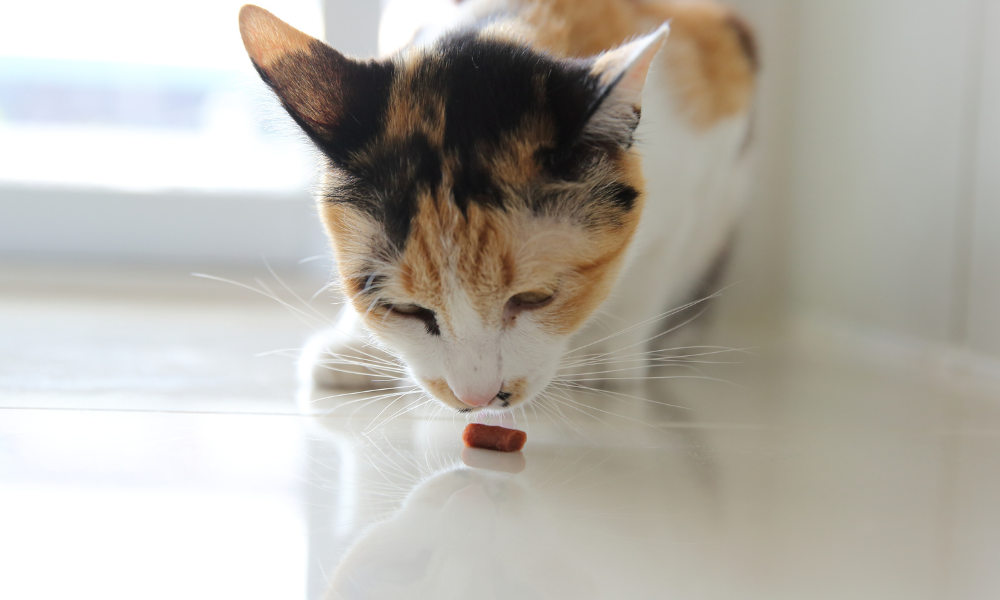
Healthy Cat Treats – Nutrition 101:
Wait, when are we going to talk about healthy cat treats? Soon enough. But if we’re on the subject of treats and nutrition, you need to get your info from a reputable source. It doesn’t get any more reputable than the Clinical Nutrition Services, a part of the Cummings School of Veterinary Medicine at Tufts University. They discuss everything from nutrition basics to how to read pet food labels.
Don’t be scared of by-products. They are yummy for your cat! There, I said it.
Probably going to ruffle some feathers here. See the “Life” in CatVetLife? My experience as a cancer survivor (i.e. life is too short) has decreased my filter and allowed me to speak my mind a little more…
I absolutely LOVE this article from Tufts about by-products. Everyone thinks that by-products are so bad but do they even know what they are? It’s not hair. It’s not horns. It’s not trash from the floor.
By-products are organs like liver and heart that cats love! Do you think that if a cat was eating a mouse, she would just nibble on their little mousey legs and leave the rest for scavengers? No! How much she ate would likely depend on how hungry she was, but potentially most of the mouse, leaving only a few parts behind.
So, if you’re not sure what an ingredient really means, look it up on the Tufts website.
In the interest of space (and this is supposed to be an article about healthy cat treats), I’m not going to quote the entire article, though I’d love to. But here’s an important paragraph to introduce you to what by-products are:
“By-products (mainly organ meats and entrails) often provide more nutrients than muscle meats on a per-weight basis and are important components (and even delicacies) of human diets in other countries. One only need to travel abroad and visit a meat market to see that many of the foods that we are squeamish about feeding to our pets are eaten with gusto by people in other countries. The term “by-product” comes from the fact that they are the leftovers from animal carcasses once the desirable (for Americans) muscle meat has been removed, not because these parts of the animal are inferior in quality, safety, or nutrition.”
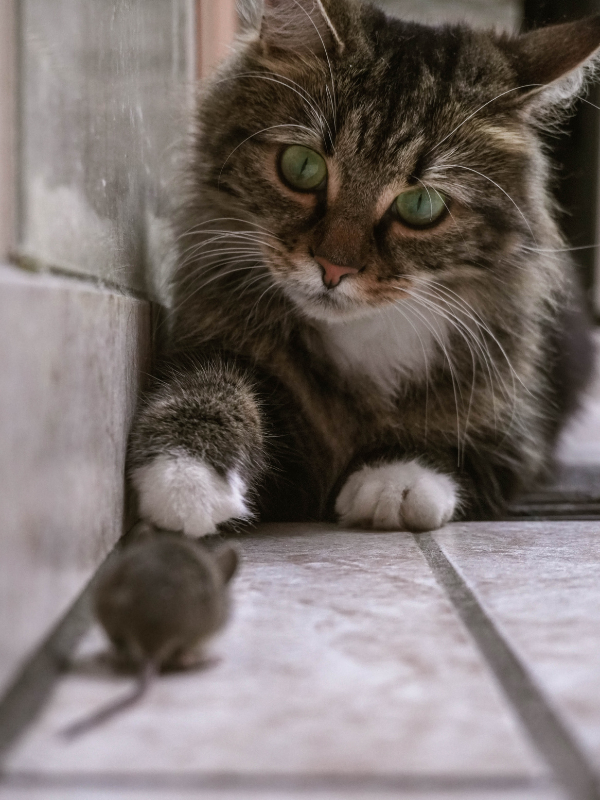
What About Artificial Colors…(that your cat may not even see)?
How well do cats see? Not as well as humans. We “think” they see combos of blue, green, and gray, whereas yellow, red, orange, brown are not really in their range.
The back of the eye (called the retina) has two types of cells: rods and cones. The cones are what help differentiate color and cats have ten times less cones than we humans do.
So knowing that, what’s up with so many cat treats having artificial colors when the cats probably can’t distinguish them anyway? Probably not going to kill them, but I do try to avoid artificial colors.
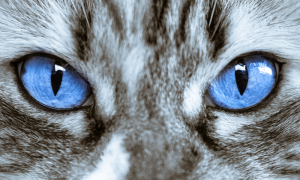
Oh, you know they love that multi-colored Party Mix! Trust me, it has its place. When we have sick kitties who are hospitalized we will do just about anything to get them to eat.
More than once I’ve found myself inside of a cat’s kennel shaking a bag of Temptations and making up a little song to go with it. No shame in my game! But for everyday use, let’s make smart decisions when choosing healthy homemade and non-homemade treats for our cats.
*FTC Disclosure: This post contains affiliate links. If you make a purchase after clicking on the links, I will get a small commission at NO additional cost to you. I only recommend products that I believe in! I am an affiliate for both Amazon and other online retailers. As an Amazon Associate I earn from qualifying purchases.
How About Dehydrated Cat Treats?
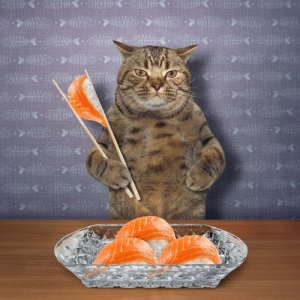
My cats eat an all-canned diet so giving them the occasional snack to crunch on is a great treat for them and it’s fun for me. I do like treats that tend to break up into little pieces and act like a topper (like a special seasoning).
One would think that keeping it really simple and recommending plain, dehydrated chicken (or fish) would be the way to go. However, there’s a problem with this.
Despite the fact that plain, dehydrated treats are not raw, it turns out that freeze drying / dehydrating doesn’t kill the bacteria like you’d think it would!
Take a look at this post on Freeze Dried vs Fresh vs Frozen Raw Pet Foods (which includes treats). Dr. Scott Weese is a well-known veterinarian, internist and infectious disease guru. He authors the Worms & Germs Blog to promote safe pet ownership from infectious disease.
According to Dr. Weese: “…there’s little reason to believe there would be much difference between these types of diets when it comes to the microbes we’re concerned about. When I want to preserve bacteria, I freeze them or freeze-dry them – those are actually the preferred methods for long-term storage of bacteria. Freezing or freeze-drying is a pretty hospitable process and state for most bacteria.”
Dang it! No dehydrated treats? I’ll admit, I’ve fed many of these in the past. But I wouldn’t give my cats a piece of raw chicken breast that I was about to cook (um, Salmonella anyone?) so why would I give them dehydrated chicken that may still have the same bacteria (There’s an asterisk to this. Keep reading…)? It’s up to you to research the company making the treat and decide for yourself.
Now, our food sources in the US are generally quite safe, but infectious disease outbreaks still occur. Did you know the CDC has a list of multistate foodborne outbreak notices?
PS – My cat Biscuit doesn’t give a flip about these fun facts and will steal a piece of raw chicken, steak, or fish in a heartbeat. You gotta keep an eye on that one!
In light of this info, I generally prefer cooked treats for safety reasons and commercial treats over homemade ones so that I know exactly how many calories I am giving. Nonetheless, let’s discuss what dehydrated treats I do like and we’ll also delve into homemade cat treats later on.
So, What ARE My Favorite Non-Homemade Healthy Cat Treats?
Are NO dehydrated treats safe? Well, it depends on your definition of safe. If you do want to feed dehydrated treats, you’ll want to look for those that have undergone something called HPP (aka High Pressure Processing). This is a not inexpensive procedure where foods are exposed to extremely high pressures to reduce (not eliminate) harmful bacteria.
Some companies acknowledge this risk and have protocols to reduce it. Others do not. How do you know who does what? Some of the brands that use HPP are Nature’s Variety and Stella and Chewy.
These Stella and Chewy chicken breast treats are nothing but chicken (HPP treated).
I like (and my cats love) these Instinct Raw Boost Mixers, which come in multiple flavors. The Instinct brand is owned by Nature’s Variety (who use HPP). These are TOPPERS / TREATS and should NOT be your cat’s main diet. They are 16 kcal/Tbsp, so your end result could be variable depending on if your tablespoons are scant or overflowing (you know who you are).
The Salmon Skin and Coat Health flavored treats are 19 kcal/Tbsp. If your cat is needs a specific amount of calories per day (i.e. she’s on a diet), I would recommend counting out how many pieces you get in a Tbsp so that you feed the exact same number of treats each time.
Pill pockets (made by Greenies) – Having a cat who loves pill pockets can be a life saver – literally! Pill pockets are small, soft treats that can hide a pill inside. I will often use just half of a pocket, as sometimes a whole pocket (with the pill inside) is too big for a cat’s small mouth. They’ve got more ingredients than the plain, dehydrated treats, but they can be so handy when medicating your cat.
Pro Tip – Get your kitten used to the taste of an occasional Pill Pocket now and you’ll thank yourself later.
If your cat won’t eat standard Pill Pockets I would also try Vetriscience dog-sized treats (yes, they’re ok for cats) and pinch off a tiny bit. Vetriscience is a respected brand and I recommend their products all the time, especially their Perio Support Powder as an easy way to enhance your cat’s oral health and Composure Treats to help nervous kitties relax.
Need to hide a pill with a hypoallergenic option? Maddie’s American Easy Pill Paste doesn’t contain the most common allergens such as chicken or fish. But make sure to clear this with your vet first though! You likely do not want to introduce this treat while in the middle of a hypoallergenic food trial.
In our hospital we’ve also successfully tried Tricky Treats made by Pala-Tech. These individually wrapped treats are made of hydrolyzed proteins, so they should also be safe for food allergic cats (again, discuss with your vet).
Hydrolyzed means that the protein source is broken down into a very small molecule such that the body doesn’t recognize it as that protein. In other words, your cat may be eating chicken but her body doesn’t know that.
Chicken baby food – really? Yes, cats love it! We go through cases of the stuff in my feline hospital. We love to feed it to the cats while they’re getting their blood drawn. It’s a wonderful distractor.
We recommend chicken baby food all the time for mixing powdered medications into. Just make sure it contains only chicken, water, and cornstarch (no onion powder or other flavorings). Again, this is only to be used as a treat, not as a large part of your cat’s diet.
What about regular Greenies? The Oven-Roasted Chicken flavor is 1.4 kcal/treat, so that’s good! They are green because they are colored with fruit juice. And of course, cats love them. But remember, that “green” is for us, not the cat.
Pro Tip: Coat your pill with some Pill Pocket then “glue” it to the back of a Greenie (or whatever treat they love). First, give them one or two plain treats to get them excited. Then give them the treat with the pill “glued” to it and hopefully they will eat it right up!
Ooh, or how about just giving them something to chew on (i.e. a zero-calorie positive interaction)? You can show your cat love in many other ways besides food.
These Silvervine Stick Toys would be fun to carry in your cat’s mouth, drop and bat around, then repeat!
Please note: you must supervise your cat with this toy. Why? To make sure that the sisal rope doesn’t come off and then they eat the rope. That could be a bad situation. But if you’re watching them, go for it! Just put it away when they’re finished.

Another idea when feeding healthy cat treats is to make your kitty work for them (i.e. nothing in life is free). In addition to using treats for training, you can allow your cat to express her natural hunting desires with these mice feeders by Doc and Phoebe’s.
Simply put a single treat into each mouse-shaped container, hide them (make it easy in the beginning) and let your cat hunt for her snack.
Furthermore, instead of simply handing your cat a treat, how about throwing a single piece across the room to encourage her off the couch and get her four little legs moving!
Healthy Homemade Cat Treat Recipes
I don’t know about you, but my busy life does not allow me to make homemade treats for my cats. But if you do, great! Homemade cat treats would also be a fun gift for fellow cat lovers during the holidays.
You could put them in these cute little cellophane paw print treat bags. It would also be a fun project with your kids. Ok, now I’ve convinced myself that I need to make time for this activity.
We’ve got two options for homemade treats. One is to make the treat out of the food that your kitty already eats. Assuming it’s a complete and balanced diet (and not intended for “supplemental feeding”), these treats are similar to feeding regular cat food (though baking them does change their nutritional properties).
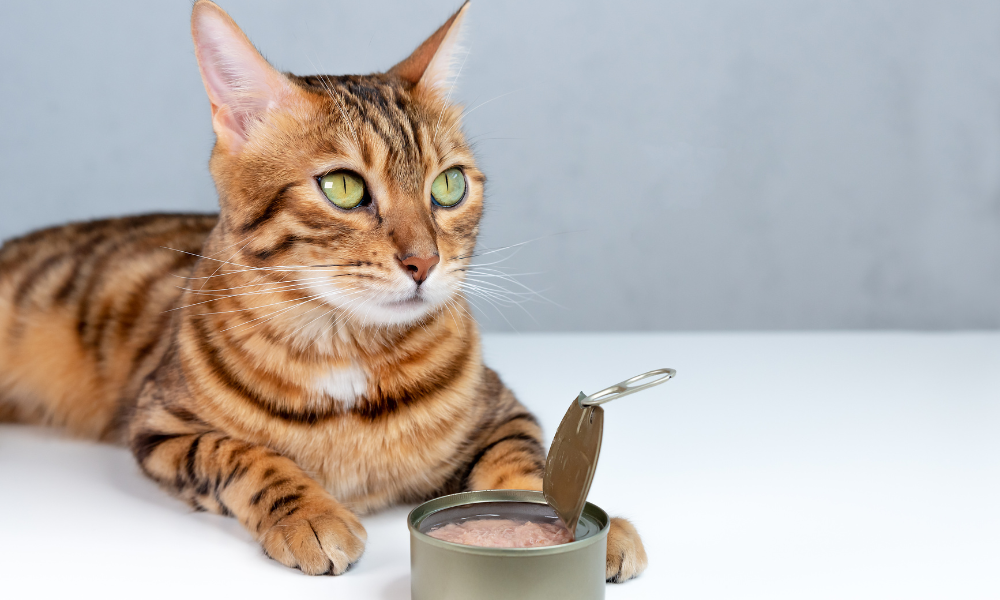
I found (and copied) these recipes straight from Hill’s:
Healthy Cat Treats Made from Canned Cat Food:
- Open the can and shake the loaf of cat food out of the can.
- Cut the loaf into 1/4″ thick slices, and then cut the slices into bite-sized pieces.
- Bake the cat treats in a microwave oven on high for approximately 2½ to 3 minutes. For a conventional oven, follow the instructions above and place the bite-sized pieces on an ungreased cookie sheet and bake at 350 degrees for approximately 30 minutes or until crispy.
- Cool completely before storing or feeding the treats to your cat.
Snack “Triangles” from Canned Cat Food:
- Preheat oven to 350 degrees.
- Spread 1/2 of a 5.5 oz can of cat food onto a sheet of waxed paper.
- Cut the flattened cat food into triangles, each 1/2 inch thick.
- Place the triangles on an ungreased cookie sheet and bake in the oven for 15 minutes.
- Flip the triangles, and bake for another 15 minutes.
- Let cat treats cool completely before serving to your cat.
Gravy from Canned Cat Food:
- Crumble 1/2 of a 5.5 oz. can of cat food into a measuring cup.
- Add 1/3 cup water to the measuring cup.
- Stir ingredients until the mixture is combined to the consistency of gravy.
Healthy Cat Treats from Dry Cat Food:
(Did I mention that my cats are on all-canned diet?)
- In a blender, add 2 cups of dry cat food and grind into a powder.
- Pour powder into a mixing bowl and gradually add about 1 to 1¼ cups of water, stirring until it forms a dough consistency.
- Shape into individual “treats” or “cookies” and flatten the dough using the back of a spoon (the cookies will not flatten like standard “people cookies” do.)
- Place cat treats on an ungreased cookie sheet and bake in the oven at 350 degrees for approximately 30 minutes or until crispy. Do not freeze homemade cat treats.
- Let treats cool completely before serving to your cat.
Ok, our other option is to make a treat that’s just a treat. It’s not made from cat food so it’s not complete and balanced. These treats fall into that category of “don’t exceed more than 10% of your cat’s daily calories.”
Many cats are lactose intolerant (that’s right, a saucer of milk can upset their stomach) so I avoided listing treats with milk or cheese.
Yes, I know. Plenty of cats like to lick the cereal or ice cream bowl with no issue. If that’s your cat, she tolerates it and doesn’t need to lose weight, fine! Let’s move on to treats made from ingredients other than cat food.
Here’s a 4-ingredient tuna-based healthy cat treat recipe for you to try.
- 5.5 oz can of tuna (no salt added)
- 1 cup of all-purpose flour
- 1 egg
- 1 Tbsp of dried catnip
- Preheat oven to 350 degrees
- Blend all ingredients until smooth
- Place ¼ tsp dollops onto a parchment-lined cookie sheet and flatten (like a peanut butter cookie)
- Bake for 15 minutes
More homemade healthy cat treat options:
These Carrot and Catnip treats contain carrots, dried catnip, olive oil, flour, egg and water – no bad stuff. Try them an let me know if your cats like them!

I’m also liking these Fishy Cat Treats made with anchovies. Why? Anchovies are super-high in Omega-3 Fatty Acids which are good for your cat’s joints, skin, brain, and kidneys!
Choose anchovies that are in water and unsalted, but that seemed hard to find. Instead, you could substitute these sustainably caught sardines. They’re in water and unsalted – yea!
Remember to store any homemade cat treats in an airtight container and use within 3-5 days so they don’t spoil. The OXO brand never disappoints.
Now, how many calories do these homemade treats contain? I have no idea! So we can’t easily calculate what 10% equates to.
If you’re going to make homemade treats, do it as a fun project, but then personally I would stick to commercial treats for everyday use so we know exactly how many calories we’re feeding.
What is your cat’s favorite treat? Don’t worry… it’s a no judgement zone. Comment below!
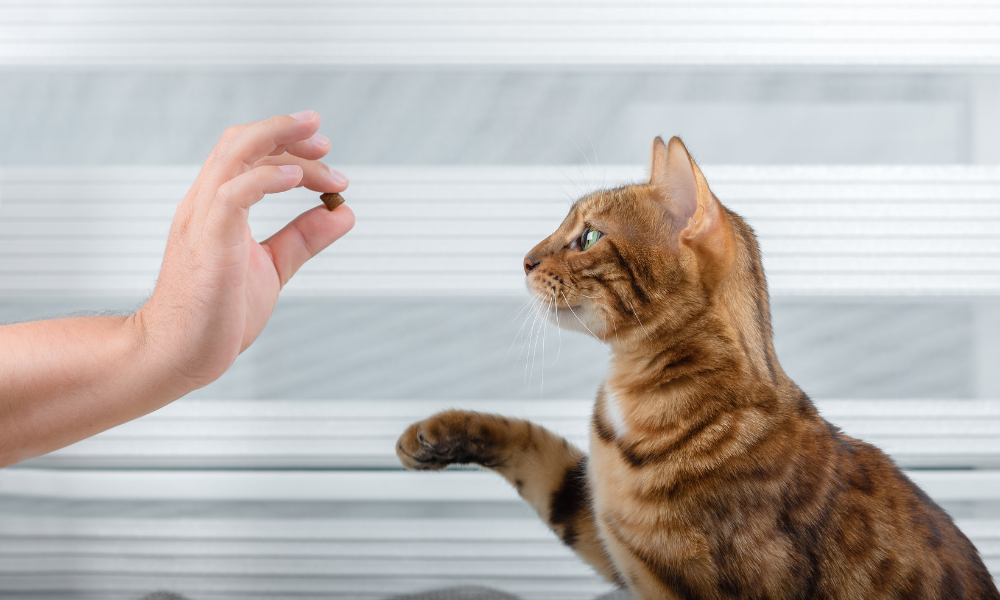





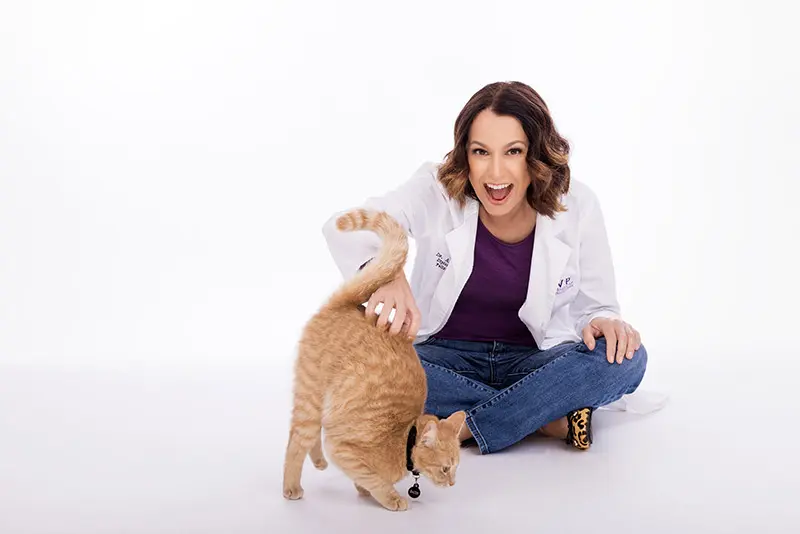










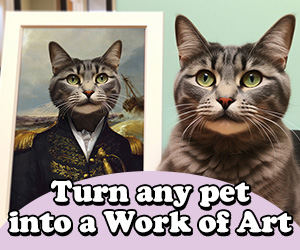
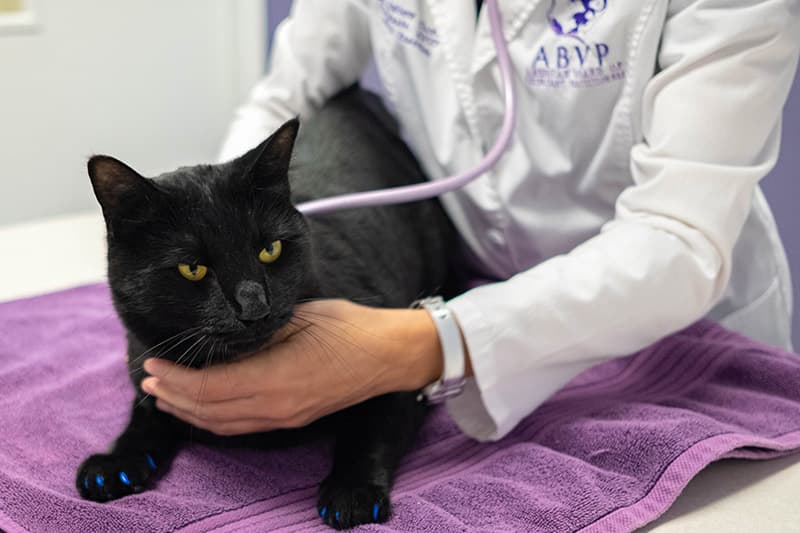
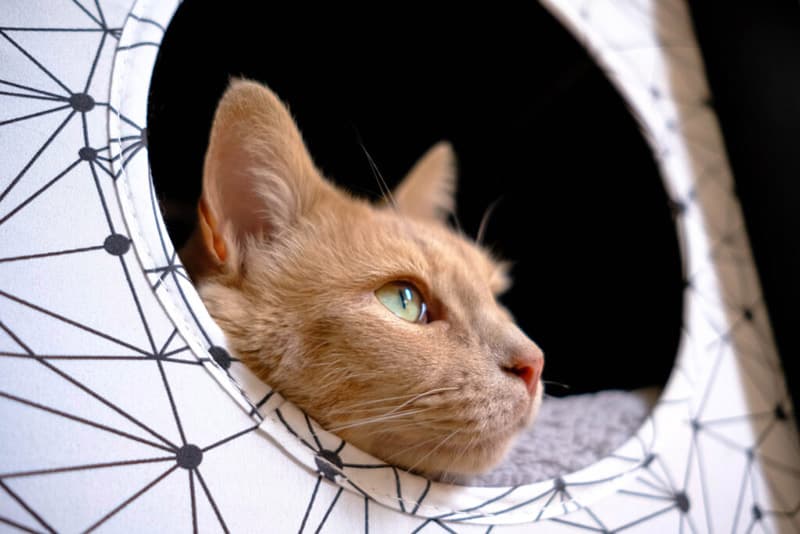

6 Responses
Chicken baby food is a all time favorite treat for my gang! I initially learned it was one of the foods used to tempt cats who had a procedure at the Clinic. Such a informative article with many suggestions for healthy treats. I’m looking forward to trying many!
Yes! The cats love it!
I cannot seem to find a groomer for my 2 year old 20 lb Maine Coon. I’ve tried 3 & no one meets her needs.
I always pre-medicate her first.
Can you help me?
I’m sorry but I don’t know where you are located! I recommend calling a feline-specific veterinary hospital to inquire if they have grooming services.
We use pieces of the baby food chicken sticks (think Vienna Sausages minus all the salt and preservatives) to give pills. Our cats go nuts for them! They only ever get the chicken sticks for pill time so it’s a really special treat and apparently covers the taste well.
We do, however, have a *very* picky boy who only ever eats kibble and knows when we’re trying to sneak him pills. He’s also unfortunately the only one that needs them regularly!
I’ve tried various things to move him away from the all-kibble diet, but he’ll just starve himself otherwise. Any suggestions?
Transitioning to canned food is a marathon, not a sprint! Here are some tips: https://catvetlife.com/eight-tips-transitioning-your-cat-to-canned-food/